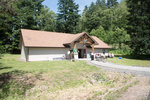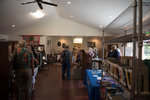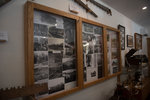


A new museum opened Thursday in Morton focusing on the history of the people who lived in the area during the heyday of the timber and railroad industry and when Morton served as a hub for such activity.
Funded by state and federal grants, the construction and opening of the Interpretive Center Museum, located at 194 E. Main Ave. in Morton, has been a goal for years, said Marc Fisher, president of the Cowlitz River Valley Historical Society.
“This is an old Indian transit point, that’s why Highway 7, 12 and 508 meet here,” said Fisher.
The Cowlitz River Valley Historical Society runs the museum — which Fisher said focuses on the history of the Cowlitz River Valley from Packwood west.
Fisher said the artifacts in the museum have been in the society’s possession for some time, but have been housed in different locations. The museum serves as a place to store them all in one structure.
“This is pretty much a happy day for everybody,” said John Miller, a member of the Cowlitz River Valley Historical Society, on Thursday.
A ribbon cutting ceremony took place earlier that day and balloons adorned some entrances in celebration of the opening and a table was stocked with celebratory coffee and cake. People milled about the museum, taking in the historical artifacts that trace back to 1800s industry, art, leisure and everyday life — accompanied by signs explaining the items’ use and their place in history.
“There’s a lot of history here,” said Miller.
Understanding the context of history is always a work in progress, he said, and as such the museum is likely to always be a work in progress, too. Every artifact fits into a piece of a puzzle, he said — it can’t just be a standalone object, it needs to find its place among the collective past of the place.
“Every time I go in there, it’s ‘Oh, I didn’t know that,’ or ‘Oh, this confirms what I knew,’” Miller said.
Miller said sometimes an artifact’s origin — or what its use might have been — isn’t even immediately apparent. Some old tools might appear like scrap metal at first.
“But it’s not scrap at all, it was a tool that was used,” he said. Finding out what that tool was and how it was used is just another piece of the puzzle, he said.
The historical society has more items than are currently on display, so Miller said the exhibits are likely to be rotating.
The museum is open every day from 10 a.m. to 4 p.m.